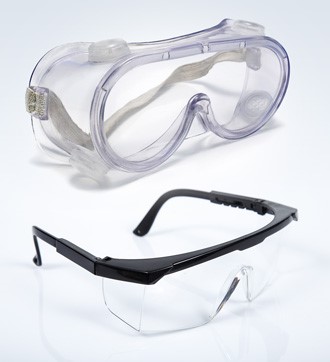Several recent incidents have occurred at the University in which a chemical or infectious material splashed or splattered into the eye because the individual was not wearing the correct type of eye protection for the hazards they faced, or not wearing eye protection at all. You should always evaluate your workplace for potential eye hazards so you can select the appropriate safety equipment.
Eyeglasses versus safety glasses or goggles
Eyeglasses are never a substitute for safety glasses or safety goggles. There are plenty of eye protection options that fit well over your prescription eyeglasses.
Safety glasses versus safety goggles
Safety glasses provide impact protection; however, they are not always adequate eye protection for your work. Safety glasses have small gaps around the lenses that can make your eyes vulnerable to liquid splashes and dust. Even safety glasses with wraparound lenses cannot provide the same level of protection as safety goggles.
Safety goggles are a better option than safety glasses when the following hazards are potentially present in your workspace:
- High-velocity debris and blunt impacts
- Splashing liquids and airborne droplets
- Airborne dust particles
- Caustic vapors
Safety goggles provide 360-degree protection from such hazards due to a tight, form-fitting facial seal.
Types of safety goggles
Safety goggles provide adequate protection from these hazards. However, you need to choose the correct type of safety goggle.
Common types include:
Direct vent: These goggles have multiple perforations around their body to promote air flow, which reduces lens fogging. They are primarily used for impact protection. Do not use this type of goggle for liquid, dust or caustic vapor protection.
Indirect vent: These goggles use covered vents to increase air flow. They provide better protection from liquid splash and dust, but do not use them around caustic vapors. Even though the covered vents help with airflow, indirect vent goggles will fog up more often. Models with dual-pane lenses or an anti-fog coating are available.
Non-vented: These goggles are completely sealed and don’t have any vents. They provide excellent protection from impact, splash, dust and caustic vapors. Due to the lack of vents, these goggles tend to fog up quickly, so we recommend using models with an anti-fog lens.
Save your sight and choose the right safety glasses or goggles for your work!
For more information, please visit the Personal Protective Equipment (PPE) page.
_________________________________
Want more environmental health and safety news? Read the latest news and subscribe to the EH&S newsletter.
